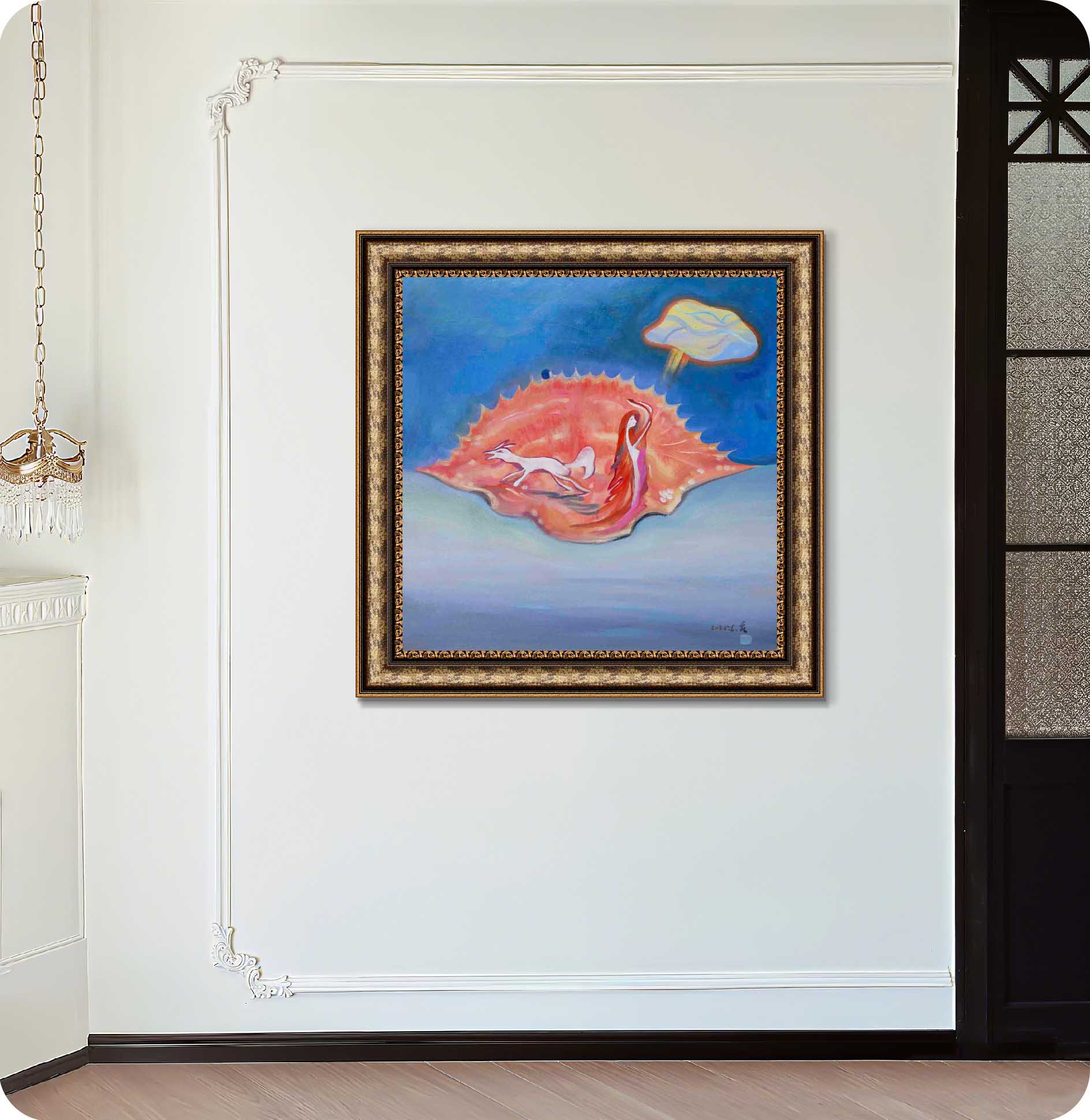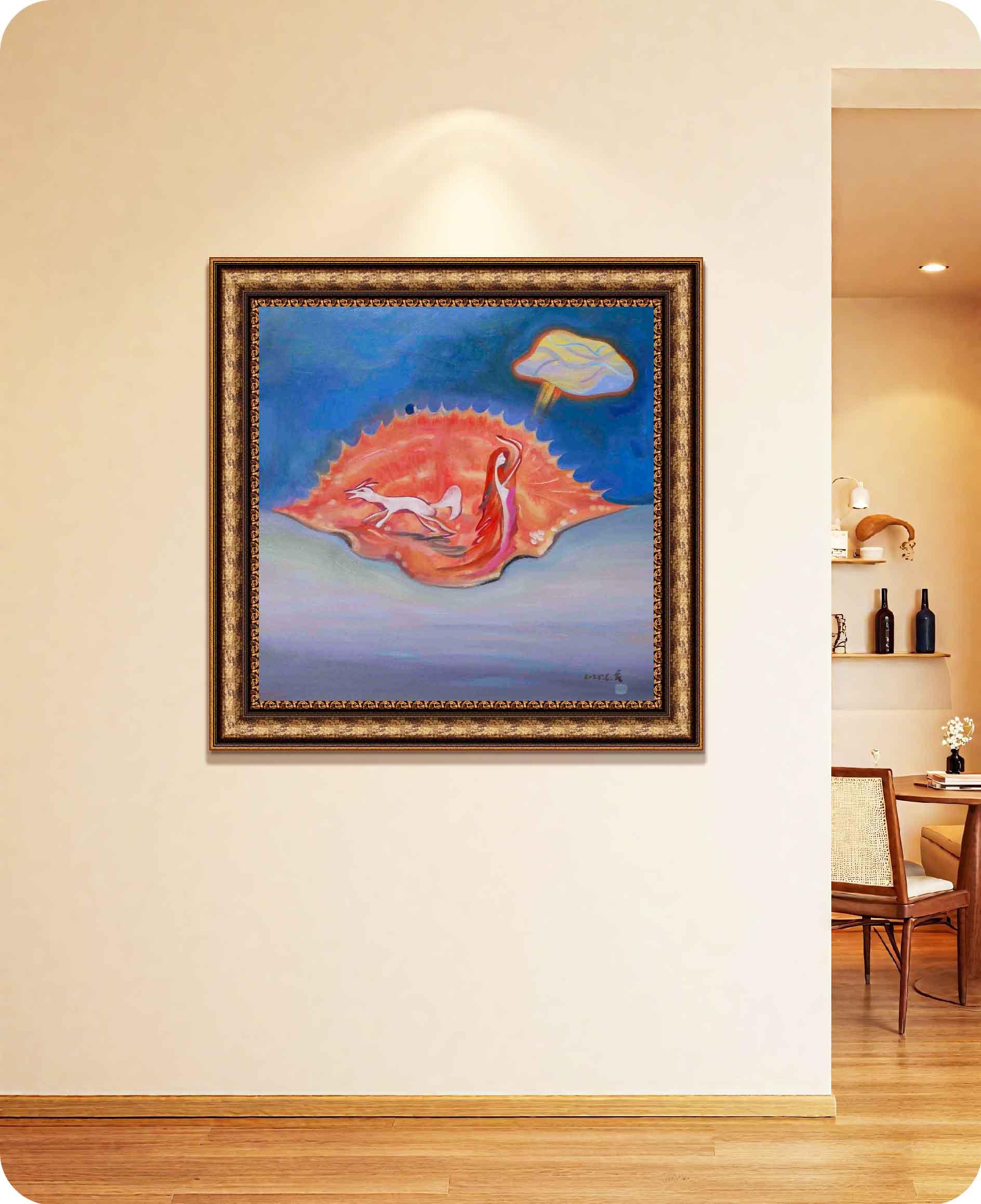The theme of this year's painting clearly states one - the makeup of desire. People's various desires are wrapped under various makeups. Desires are the intertwining of happiness and pain in life. Either straightforward or subtle, they will appear in makeup, forming a profound look of an era.
Inches: 15.7 x 15.7 in
Size without the frame: 40 x 40 cm
Country: China
Date: 2025
Materials: Oil paint on wood
Condition: well preserved
Creative themes and style | My works revolve around the creative concept of "The land of humanity, and the people upon it".The people in the painting are people in nature, and the lines, shapes, and colors are close to nature. The nature in the painting is nature in the eyes of humans, existing in interaction with humans.I don’t pursue a series of works with a fixed and continuous style. I hope that the style of the pictures will synchronize with the changes in my life and always remain oscillating. The performance of the work must be in sync with the development of one's own life in order to be Sincere and powerful.Ideas are later.
An Interview with Artist Philo by Artphiloso Gallery
If you would like to collect this artwork or know more about the artist, please contact us.


Form and Symbolic Structure
This painting constructs an otherworldly scene through fantastical juxtapositions. The monumental crab carapace functions as a kind of interdimensional vessel, distorting conventional notions of scale and reality. Upon it, the human and fox figures are not depicted with naturalistic precision but rather with fluid, spontaneous contours that suggest structure while resisting rigid definition. This dreamlike figuration recalls the poetic approach of Marc Chagall, where symbolic presence outweighs literal description.
Compositional Balance
The carapace dominates the horizontal plane, spanning the canvas like a stage for the drama. Above it, a luminous cloud-like form hovers, radiating uncanny energy and echoing the shoreline-like curve below. The placement of the human and fox atop the shell guides the viewer’s gaze diagonally, establishing an asymmetrical yet harmonious tension reminiscent of the compositional strategies used in surrealist frameworks.
Color and Emotional Atmosphere
The color palette embodies bold harmony and symbolic resonance. A deep blue background establishes an atmosphere of stillness and cosmic depth, against which the warm russet tones of the shell surge with vitality. The yellow-blue luminosity of the cloud introduces a fantastical counterpoint, intensifying the scene with a sense of mystery. The juxtaposition of warm and cool tones creates both contrast and cohesion, producing a chromatic intensity akin to Paul Gauguin’s emotionally charged color explorations.
Brushwork and Gesture
The brushwork alternates between expressive rhythm and delicate precision. The shell’s rugged edge is defined through textured, assertive strokes, while the flowing lines of the human figure’s drapery and the fox’s form introduce refinement. This shifting quality translates the painter’s emotional impulse into visual rhythm, echoing the free, lyrical gestures often found in Joan Miró’s works. The result conveys an energy of “organic vitality”, where intention and spontaneity are fused.
Thematic Resonance
At a thematic level, the convergence of human, animal, shell, and radiant cloud creates a surreal allegory. This painting suggests a liminal zone where spiritual desolation intersects with fragile hope. The figures’ placement within this symbolic environment invites reflection on companionship, survival, and the search for transcendence. By situating the scene between reality and dream, the work probes questions of existential solitude while hinting at the persistence of connection and meaning.
Conceptual Significance
Through its distinct visual syntax, this painting advances a contemporary surrealist narrative. The imagery is not intended as mere fantasy but as a symbolic lexicon—a means of accessing unconscious depths and stimulating contemplation about life, resilience, and the enigmatic.
Marc Chagall, The Birthday
Both works employ fantastical figuration and dreamlike hues to express inner states, though Chagall leans toward personal intimacy while this painting embraces cosmic allegory.
Salvador Dalí, The Persistence of Memory
Like Dalí, this painting explores the realm of the subconscious through surreal architecture and distorted scale, though its tone is less about disquiet and more about poetic mystery.
Joan Miró, Harlequin’s Carnival
Miró’s emphasis on playful spontaneity and fluid gesture resonates with the brushwork here, where motion and vitality outweigh literal description.
The intense, highly saturated azure blue and warm orange create a powerful cool-warm contrast, generating a dreamlike tension. This color palette not only emphasizes the visual focus on the central subject but also establishes an atmosphere hovering between reality and fantasy – a distinctly surreal atmosphere.
The central orange form, with its distinct radiating "ridges," is actually the hard back shell of a crab. Its presence suggests themes of protection and containment. It also symbolizes a kind of self-contained microcosm, a small universe of its own.
Rendered with simple lines, the white animal resembles both a fox and a dog, conveying a strong sense of speed and alertness. It represents a guardian spirit, a guide, and is also an embodiment of primal force. It shares a dynamic, interactive relationship with the nearby human figure.
The yellow cloud mass in the upper right, with its flowing lines and apparent glow, defies realistic logic. It functions more as a visual symbol of mental visions, harbingers, or perhaps an unknown energy, adding an element of narrative suspense to the scene.
The feeling of vastness comes from the expansive blue background and the generous use of negative space. The sense of intimacy, however, stems from the small, detailed scene contained within the crab shell. It makes the viewer feel like they are peering into a private, enclosed, yet deeply mysterious ritual.
A: Click here to view ARTPHILOSO's Guide for Collectors.
More paintings from this series:
End of the Blazing Sun 1 End of the Blazing Sun 2
End of the Blazing Sun 5 End of the Blazing Sun 6
